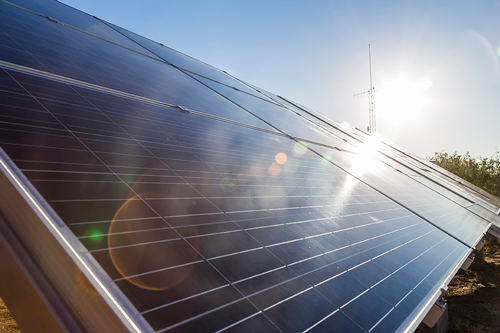
A glimpse into how solar panels work
Posted by Guest Blogger on July 18, 2018
Powering a home using the sun’s energy is not a new concept, especially with recent technological advances and lower costs, solar has become an attractive option to many homeowners.
This promising source of renewable energy has also become increasingly accessible as many electric cooperatives are offering community solar programs as an alternative to purchasing a rooftop solar array. This helps keep costs down and puts the burden of maintaining and operating the system on the co-op.
The question that remains for many: How do solar panels actually generate electricity? Let’s break this seemingly abstract concept down and take a closer look at the conversion of sunlight to usable electricity.
Solar panels
The solar panels you see on street signs or rooftops consist of smaller, connected photovoltaic cells; “photo” meaning light and “voltaic” meaning the production of electricity. These cells consist of two layers of a semi-conducting material, typically silicon, which are the meat of the solar panels. These cells are infused with additional elements giving the top layer a negative charge and the bottom layer a positive charge. These two silicon layers are also sandwiched between several other coatings, including a glass casing, to optimize the PV cell’s energy production and provide protection from outside debris.
Journey of solar energy
Now that you understand the construction of these panels, let’s explore the electrical process they facilitate. Our sun emits massive amounts of solar energy each day in the form of photons, which are small particles of light. When these photons collide hard enough with PV cells, electrons are knocked loose from atoms in the top silicon layer of the cells, leaving gaps to be filled by electrons from the bottom layer. Because of the electric field created by the two silicon layers, the loose electrons will circulate through the cells in a single direction, out towards the metal sides of the solar panel, creating electricity with a direct current (DC).
This is where the power inverter comes in. The newly-generated electricity flows out of the panels, through conductive wire and into the inverter system. This system exists because the majority of our home appliances and electronics operate on an alternating current, or AC power. The inverter takes care of this discrepancy and converts the power from DC to AC, allowing us to charge our phones and watch TV using electricity generated through solar panels.
Once the electricity is in an alternating current, it flows from the inverter to supply electrical loads as needed. Any solar energy that goes unused will flow through your electrical meter and back onto the electric grid.
Incorporating solar energy
Community solar, the shared solar model electric cooperatives provide, allows co-ops to develop an array for members who can either purchase the power or lease panels. This type of program makes solar more equitable for co-op members who are unable to install rooftop solar because of geography, finance terms, maintenance or other limiting factors.
